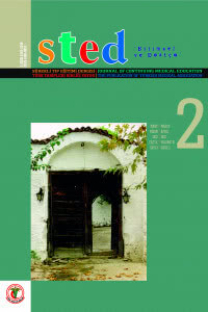Sendromik birlikteliği olmayan, ailesel preauriküler sinüs olgusu
Amaç: Preauriküler sinüs, kulak katlantısının ön, üst kısmında, çoğunlukla sağ tarafta görülür. Birinci faringeal katlantının dorsal kısmının tam olmayan kapanması sonucu oluşur. Genellikle bulgu vermez. Sendromik birlikteliği olmayan, ailesel preauriküler sinüs olgusu sunulmuştur. Olgu Sunumu: Polikliniğe başvuran sol tarafı enfekte ve sellülitli, bilateral preauriküler sinüslu 6 yaşındaki kız olgunun tanısı konarak sağaltımı yapıldı. Hastanın sistemik incelemesinde ek bir sorunu yoktu. Sorgulama sırasında aynı oluşumun babasında ve dedesinde de olduğu görüldü. Sonuç: Preauricular sinüs sık görülen bir anomali olmasına karşın birlikte görüldüðü sendromlar nedeniyle klinikte önem kazanır. Olguların %25-50'si çift taraflıdır ve %3-10'u sağırlık ve BOR sendromu (brankio-oto-renal sendrom) ile birliktedir. Enfekte olgular kliniğe gelişin en sık nedenidir. Çoğunlukla etken staphylococ’tür Sağaltım bulgulara yönelik yapılır. Yineleyen olgularda lezyonun cerrahi olarak çıkartılması önerilir.
Anahtar Kelimeler:
Kulak hastalıkları
A familial preauricular sinus case without an accompanying syndrome
Aim: Preauricular sinuses are seen in the anterosuperior part of the auricle, usually on the right side. They occur due to the incomplete closure of the dorsal part of first branchial cleft. They are usually asymptomatic. A familial preauricular sinus case without an accompanying syndrome has been presented. Case Report: A 6-year-old girl, who has applied to our clinic with bilateral preauricular sinus with the left side infected and with cellulitis, has been diagnosed and debridment has been done. No other problems were found in the systemic examination of the patient. While taking history, it was noted that the same formation was also present in her father and grandfather. Conclusion: Although preauricular sinus is a commonlyencountered anomaly, its clinical importance is due to the syndromes it is seen together with. 25-50% of the cases are bilateral, and 3-10% have accompanying deafness and BOR (Branchio-Oto- Renal) syndrome. Infection is the most common cause of referring to a clinic. The agent is usually staphylococci. Debridment is tailored according to the findings. In recurring cases, surgical removal of the lesion is recommended.
Keywords:
Ear Diseases,
___
- 1.Ellies M, Laskawi R, Arglebe C, Altrogge C. Clinical evaluation and surgical management of congenital preauricular fistulas. J Oral Maxillofac Surg 1998;56:827-831.
- 2.Currie AR, King WW, Vlantis AC, Li AK. Pitfalls in the management of preauricular sinuses. Br J Surg 1996;83:1722-1724.
- 3.Prasad S, Grundfast K, Milmoe G. Management of congenital preauricular pit and sinus tract in children. Laryngoscope 1990;100:320-321.
- 4.Nofsinger YC, Tom LW, LaRossa D, Wetmore RF, Handler SD. Periauricular cysts and sinuses. Laryngoscope 1997;107:883-887.
- 5.Leung AK, Robson WL. Association of preauricular sinuses and renal anomalies. Urology 1992;40:259-261.
- 6.Raman R. Excision of preauricular sinus. Arch Otolaryngol Head Neck Surg 1990; 116: 1452.
- 7.Scheinfeld NS, Silverberg NB, Weinberg JM, Nozad V: The preauricular sinus: a review of its clinical presentation, treatment, and associations. Pediatr Dermatol 2004; 21: 191-6.
- ISSN: 1300-0853
- Yayın Aralığı: 6
- Başlangıç: 1992
- Yayıncı: -
